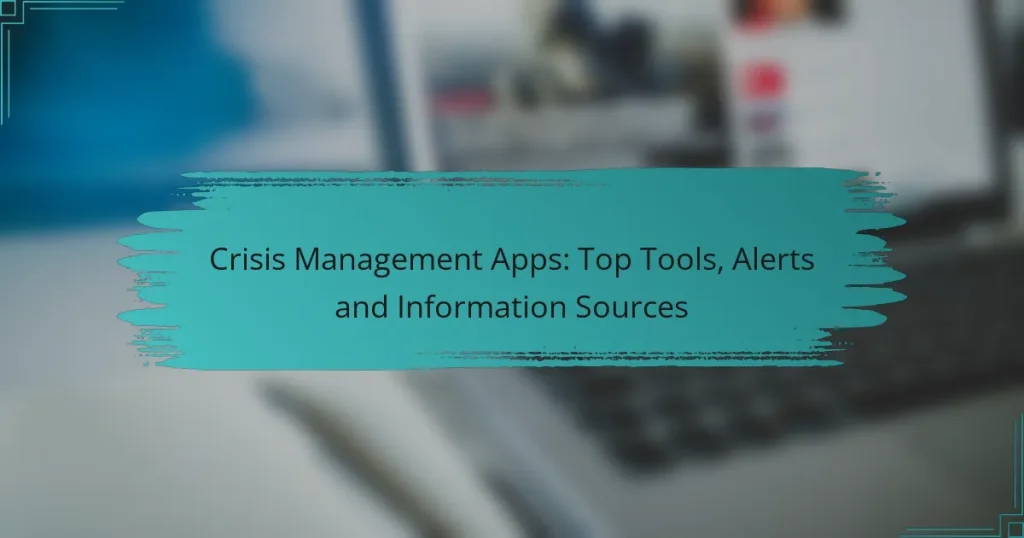Crisis management apps are vital for organizations seeking to enhance safety and operational continuity during emergencies. These tools offer real-time communication, alert systems, and information sharing, enabling users to effectively prepare for, respond to, and recover from crises. When choosing the right app, it’s important to consider features that prioritize communication, customization, and usability to ensure a swift and effective response.
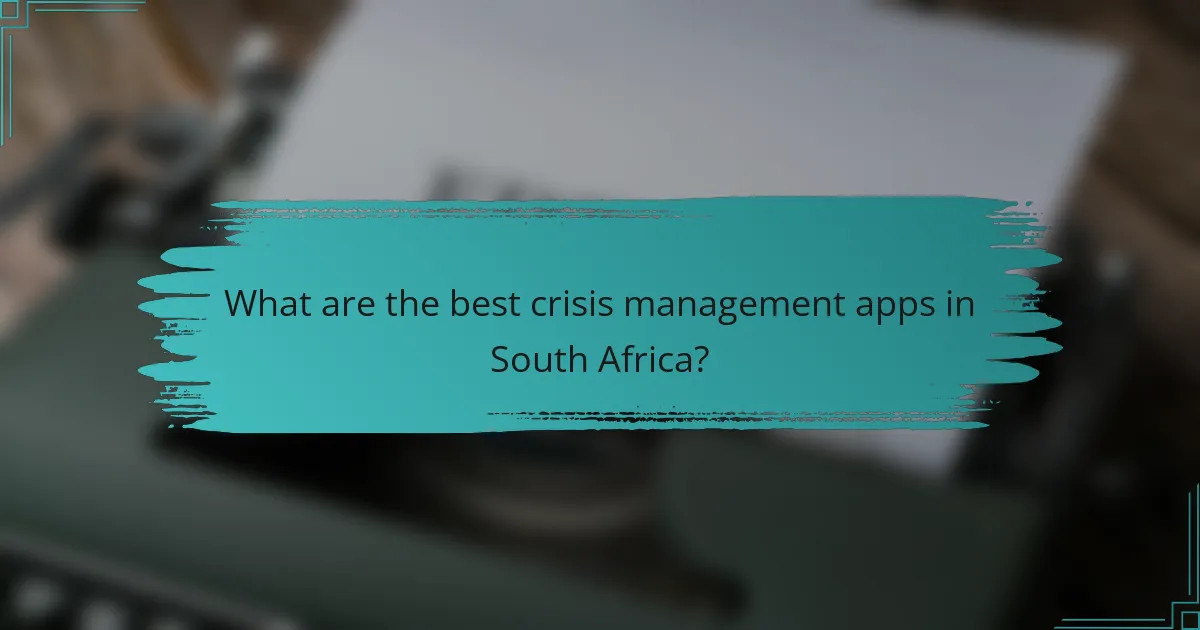
What are the best crisis management apps in South Africa?
The best crisis management apps in South Africa focus on real-time communication, alert systems, and information sharing during emergencies. These tools are essential for organizations to ensure safety and maintain operational continuity in times of crisis.
Everbridge
Everbridge is a comprehensive crisis management platform that specializes in emergency notifications and incident management. It allows organizations to send alerts to employees and stakeholders via multiple channels, including SMS, email, and voice calls.
In South Africa, Everbridge is particularly useful for businesses that need to comply with local safety regulations and ensure rapid communication during emergencies. Its user-friendly interface and robust analytics help organizations assess response effectiveness.
AlertMedia
AlertMedia provides a versatile communication platform designed for crisis management. It enables organizations to send alerts and updates quickly, ensuring that employees receive critical information in real-time.
This app is beneficial for South African companies that operate in high-risk environments, as it allows for two-way communication. Employees can report their status, which helps organizations gauge safety and respond accordingly.
OnSolve
OnSolve offers a suite of tools for crisis management, including emergency notification systems and risk intelligence. Its platform is designed to keep organizations informed and connected during emergencies.
In the South African context, OnSolve’s features can help businesses navigate local challenges, such as natural disasters or civil unrest, by providing timely alerts and actionable insights. The platform’s integration capabilities with existing systems enhance its utility.
BlackBerry AtHoc
BlackBerry AtHoc is a secure crisis communication solution that focuses on connecting organizations with their employees during emergencies. It provides real-time alerts and allows for secure messaging across various devices.
This app is particularly relevant for South African government agencies and large enterprises that prioritize data security and compliance with local regulations. Its ability to integrate with other emergency management tools makes it a strong choice for comprehensive crisis response.
Rave Mobile Safety
Rave Mobile Safety is an emergency communication platform that emphasizes community safety and engagement. It allows organizations to send alerts and gather feedback from users, enhancing situational awareness during crises.
For South African organizations, Rave Mobile Safety can be an effective tool for managing local emergencies, such as health crises or public safety incidents. Its focus on community interaction helps build trust and ensures that critical information reaches those who need it most.
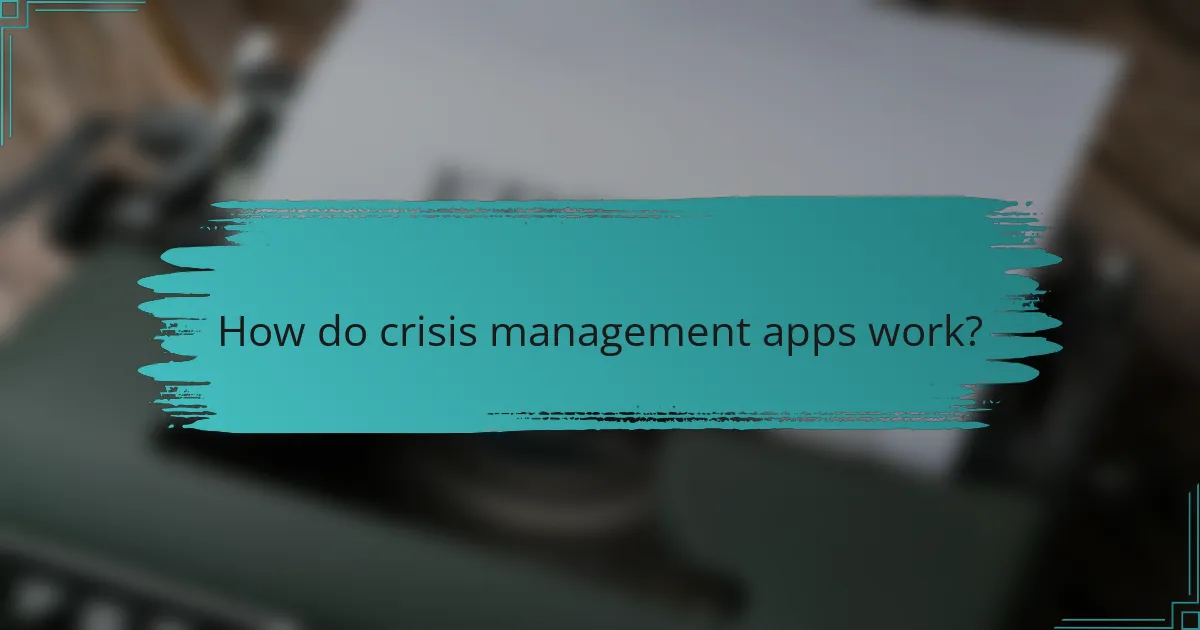
How do crisis management apps work?
Crisis management apps function by providing users with essential tools to prepare for, respond to, and recover from emergencies. They integrate real-time alerts, communication channels, and incident tracking to ensure effective management during crises.
Real-time alerts
Real-time alerts are crucial features of crisis management apps, delivering immediate notifications about emergencies or potential threats. These alerts can be sent via push notifications, SMS, or email, ensuring that users receive timely information regardless of their location.
For effective alerts, users should customize their settings to receive notifications relevant to their specific needs, such as geographical areas or types of incidents. This personalization helps filter out unnecessary information and focuses on what matters most.
Communication channels
Crisis management apps offer various communication channels to facilitate coordination among team members and stakeholders during emergencies. These channels may include chat functions, video calls, and group messaging, allowing for seamless information sharing.
To enhance communication, organizations should establish clear protocols on how to use these channels effectively. Regular training sessions can help ensure that all team members are familiar with the tools and can respond promptly in a crisis.
Incident tracking
Incident tracking features in crisis management apps allow users to monitor and document events as they unfold. This can include logging details about the incident, tracking response times, and assessing the effectiveness of the actions taken.
Utilizing incident tracking helps organizations analyze past crises to improve future responses. Keeping detailed records can also assist in compliance with regulations and provide valuable insights for post-incident reviews.
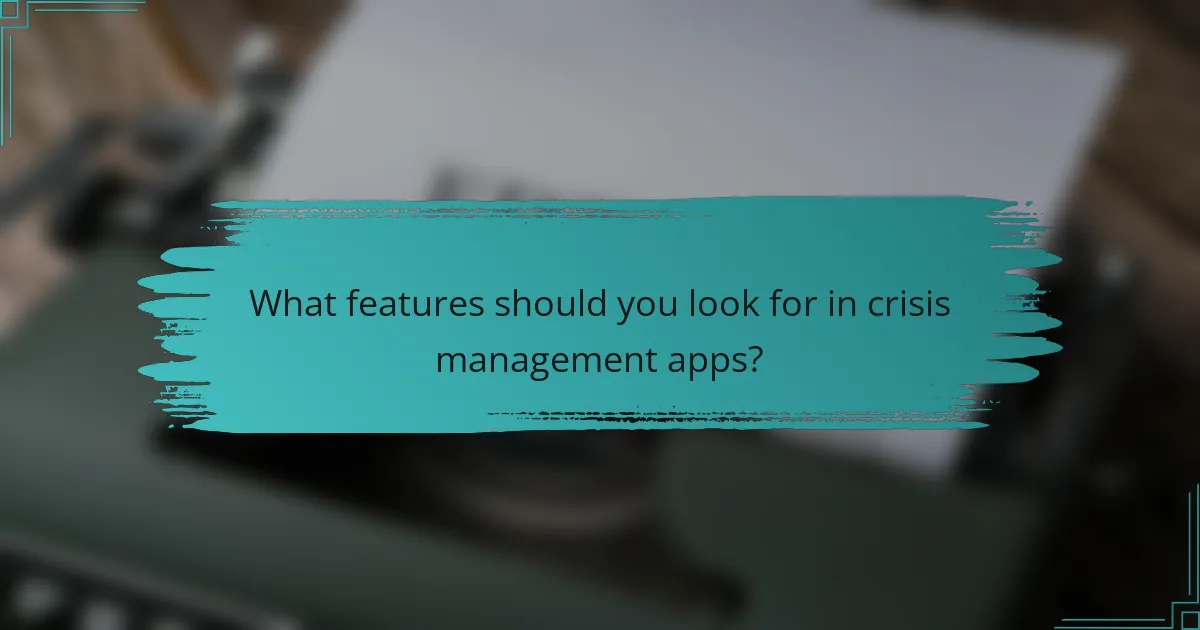
What features should you look for in crisis management apps?
When selecting crisis management apps, prioritize features that enhance communication, customization, and usability. Key functionalities include customizable alerts, multi-channel communication capabilities, and a user-friendly interface to ensure effective response during emergencies.
Customizable alerts
Customizable alerts are essential for tailoring notifications to specific needs during a crisis. Users should be able to set parameters for alerts based on severity, location, or type of incident, ensuring that the right people receive timely information. For example, a school might configure alerts for different types of emergencies, such as weather warnings or security threats.
Consider apps that allow for multiple alert types, such as push notifications, SMS, or email, to reach stakeholders through their preferred channels. This flexibility can significantly improve response times and preparedness during critical situations.
Multi-channel communication
Multi-channel communication is crucial for effective crisis management, enabling information dissemination across various platforms. Look for apps that support communication through text, voice, email, and social media to ensure that messages reach all relevant parties, including staff, emergency services, and the public.
Integrating various communication channels helps maintain clarity and reduces the risk of misinformation. For instance, during a natural disaster, an app that can simultaneously send alerts via SMS and post updates on social media can keep the community informed and engaged.
User-friendly interface
A user-friendly interface is vital for ensuring that all users can navigate the app efficiently, especially under stress. The design should be intuitive, with clear menus and easy access to critical functions like alert settings and communication tools. A straightforward layout can help users quickly find the information they need during a crisis.
When evaluating apps, consider usability testing or demos to gauge how easily team members can adapt to the interface. An app that minimizes complexity can enhance overall effectiveness in managing crises, allowing users to focus on response rather than troubleshooting technology.
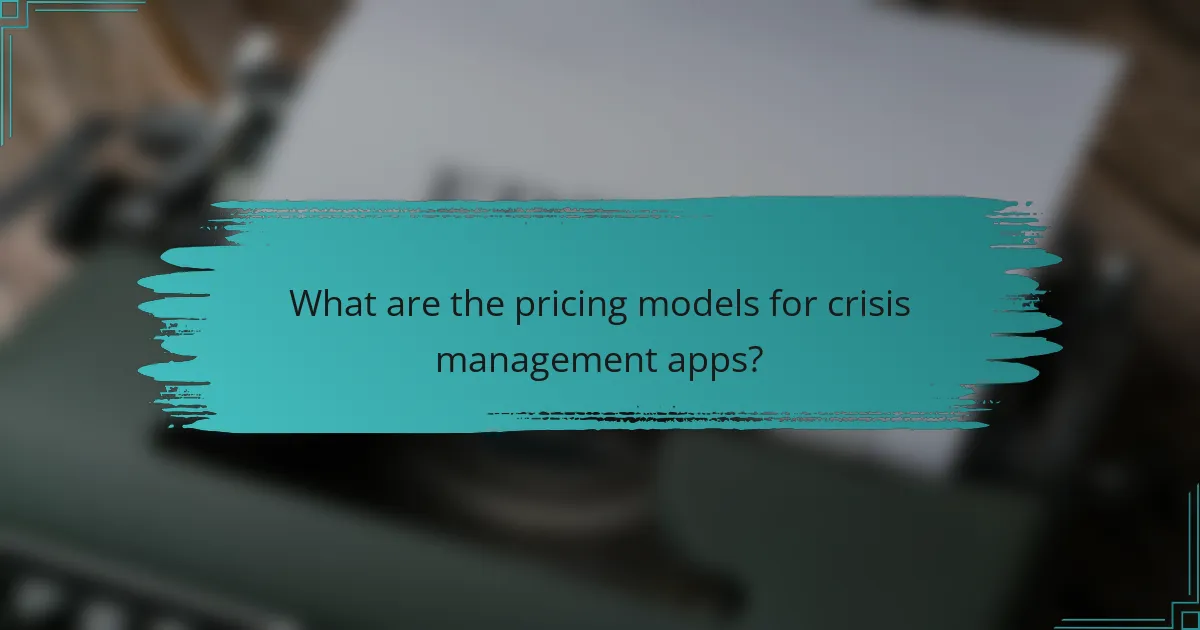
What are the pricing models for crisis management apps?
Crisis management apps typically offer various pricing models to accommodate different organizational needs. The most common models include subscription-based pricing, one-time purchase options, and free trials, each with its own advantages and considerations.
Subscription-based pricing
Subscription-based pricing is a prevalent model for crisis management apps, allowing users to pay a recurring fee, often monthly or annually. This model provides continuous access to updates, support, and new features, making it suitable for organizations that require ongoing service.
Prices can vary widely, typically ranging from $10 to $100 per user per month, depending on the features included. Organizations should assess their needs and the value of included services to determine if a subscription is cost-effective.
One-time purchase options
One-time purchase options allow organizations to buy the app outright, providing a single payment model without ongoing fees. This can be appealing for businesses that prefer to avoid recurring costs and want to maintain control over their software budget.
However, one-time purchases may not include future updates or support, which can lead to higher long-term costs if upgrades are needed. Prices for one-time purchases can range from a few hundred to several thousand dollars, depending on the app’s complexity and features.
Free trials
Many crisis management apps offer free trials, allowing organizations to test the software before committing to a purchase. Free trials typically last from a week to a month and provide full access to the app’s features.
Organizations should take advantage of free trials to evaluate usability, functionality, and whether the app meets their specific crisis management needs. During this period, it’s beneficial to involve key team members to gather diverse feedback and ensure the app aligns with organizational goals.
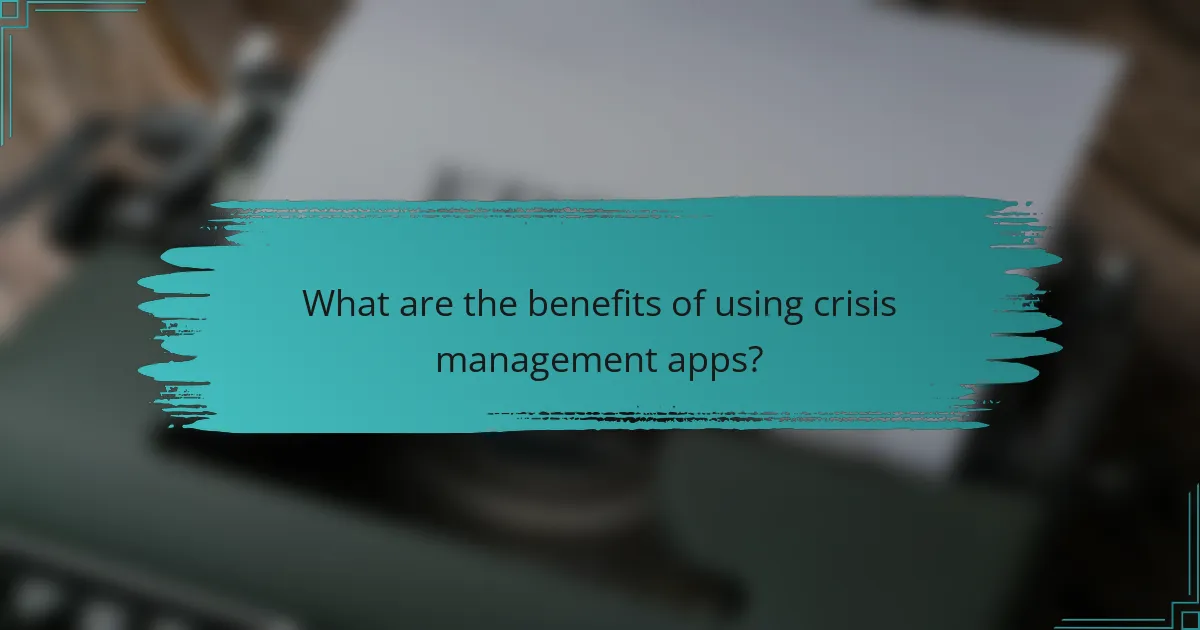
What are the benefits of using crisis management apps?
Crisis management apps offer significant advantages by streamlining emergency response, enhancing communication, and providing valuable data insights. These tools help organizations prepare for, respond to, and recover from crises more effectively.
Improved response times
One of the primary benefits of crisis management apps is their ability to improve response times during emergencies. By automating alerts and notifications, these apps ensure that the right people are informed quickly, reducing delays in action.
For example, an app can send instant alerts to designated team members within seconds, allowing them to mobilize resources and coordinate efforts efficiently. This rapid communication can be the difference between effective intervention and escalating chaos.
Enhanced communication
Crisis management apps facilitate enhanced communication among team members and stakeholders. They provide a centralized platform for sharing updates, instructions, and critical information in real-time.
Features such as group messaging, push notifications, and status updates help ensure that everyone involved is on the same page. This clarity is crucial during a crisis, where misinformation can lead to poor decision-making and increased risks.
Data analytics
Data analytics capabilities in crisis management apps allow organizations to assess their response effectiveness and identify areas for improvement. By analyzing data from past incidents, teams can develop better strategies for future crises.
These insights can include response times, resource allocation, and communication effectiveness. Organizations can use this information to refine their crisis management plans and enhance overall preparedness.
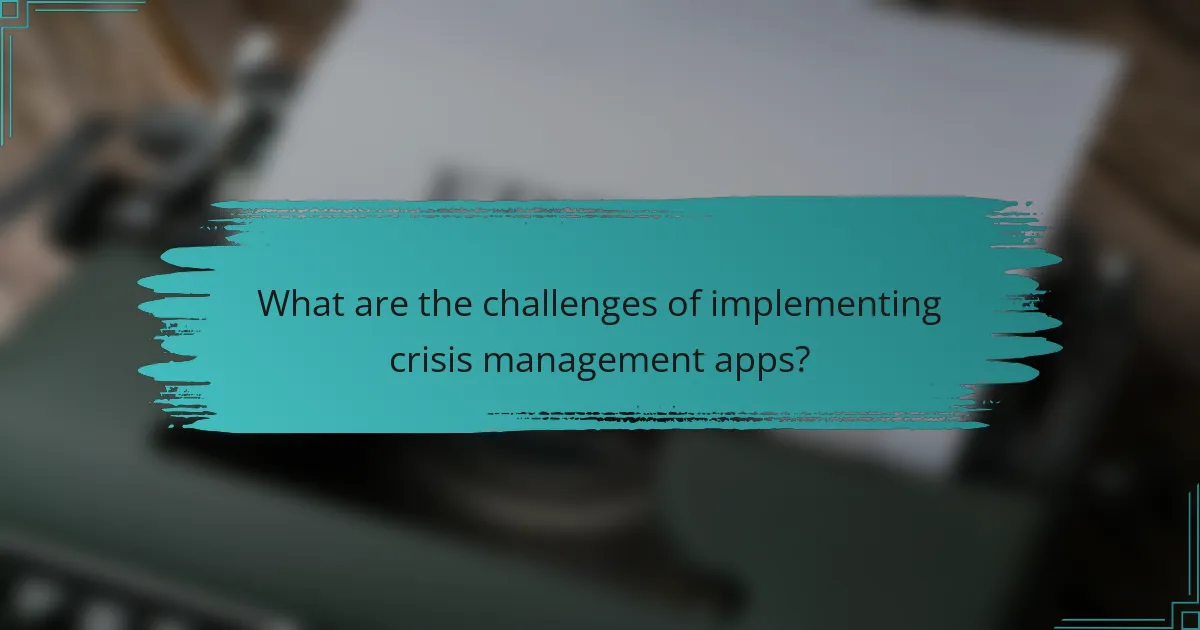
What are the challenges of implementing crisis management apps?
Implementing crisis management apps can be challenging due to integration issues, user adoption, and the need for real-time data. Organizations must navigate technical, operational, and cultural hurdles to ensure these tools are effective during emergencies.
Integration with existing systems
Integrating crisis management apps with existing systems is crucial for seamless operation. Organizations often use various software solutions for communication, data management, and incident reporting, and ensuring compatibility can be complex.
Consider the types of systems already in place, such as customer relationship management (CRM) or enterprise resource planning (ERP) systems. A successful integration will allow for real-time data sharing and streamlined workflows, enhancing the overall effectiveness of crisis response efforts.
To facilitate integration, prioritize apps that offer robust APIs and support for common data formats. Conduct thorough testing to identify potential conflicts and ensure that all systems communicate effectively during a crisis.
